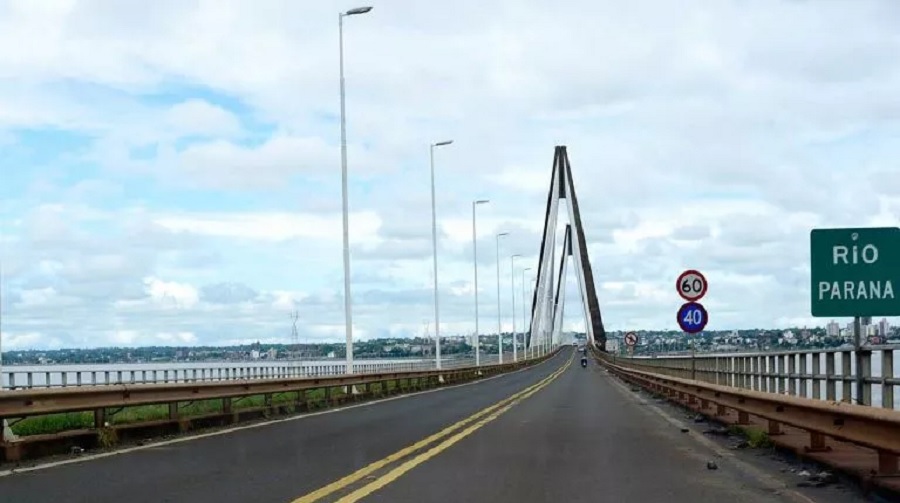RIO DE JANEIRO, BRAZIL – There was much speculation that this international viaduct would be reopened tomorrow, October 16, as a result of a meeting held between the Foreign Ministers of Argentina Santiago Cafiero and Paraguay Euclides Acevedo. Should it materialize, the crossing between Bernardo de Irigoyen and Dionisio Cerqueira, Brazil, could also be opened.
Officially, it was only announced that “in the coming days, three other border crossings in Formosa, Misiones and Corrientes would be opened.” Without confirming the date, and only stressing that it will be done progressively and respecting health standards and highlighting the joint efforts for the authorization, through safe sanitary corridors.”

This was the outcome of the meeting held at the San Martín Palace, in the Buenos Aires Retiro district, where the Ministers of Foreign Affairs of the two countries met yesterday at noon to discuss the border opening.
All official sources consulted in the national government assured that all administrative steps are ready to enable the transit of people on the bridge linking the cities of Posadas and Encarnación, closed since March last year. The same information is being provided in Paraguay, where there is greater confidence that the opening will occur tomorrow, although the protocol is still to be published.
Expectations have been mounting for the opening of the bridge in the communities of Posada and Encarnacena due to the border culture, where more than just economic issues matter. It is a geographical area used as an international crossing point, an issue that is often misunderstood in Buenos Aires. It is not a question of willingness or otherwise, rather a matter of distance from this regional reality.
When the borders were closed in March last year with the explosion of the coronavirus pandemic, the world was one thing. Today it is another.
NOTHING WILL BE THE SAME
Nothing will ever be the same as before the pandemic and the border crossings around the province of Misiones, such as the San Roque González de Santa Cruz bridge, are clear examples of the impact of this health tragedy on people’s lives.
In the past, crossing the bridge to “the other side” was the most common thing to do in the area. And that suddenly changed. The crossing was closed for 1 year and 7 months. Once it opens, a new way to “cross” will be established.
This new way is part of a health protocol developed by the authorities of Misiones and the national government, which will initially only allow the access of 800 people per day to the provincial capital. Also on the Paraguayan side a health protocol will be initially introduced, albeit without a maximum quota of people entering the province.
DEMANDS
On both sides of the border, a Covid vaccination certificate will be required. On the Argentine side, a PCR test performed in the last 72 hours prior to crossing and an antigen test to be performed at the bridge before entering the country.
Anyone interested in crossing the bridge will be required to wear a mask and to avoid crowds. Something difficult to conceive when considering the pre-pandemic scenario, with large crowds on each square meter of the bridge and endless lines in both directions. Now the situation is expected to be different. There will be a kind of mandatory route with stops at different posts to present first health and then personal documentation.
This is how the new way to cross the bridge is expected to be introduced – in post-pandemic mode, while the memory of the pain caused by the pandemic remains fresh in people’s minds. Thus, everything related to vaccination and test documentation will be performed even before personal documentation is submitted.
A maximum of 800 people per day will be able to enter Posadas through the San Roque González de Santa Cruz bridge and all will be required to present a certificate of vaccination against Covid-19, a PCR test in the last 72 hours and an antigen test in the same viaduct, according to the health protocol regulating the transit of people in this international crossing, expected to become a reality from tomorrow.
The above was anticipated yesterday and was one of the topics discussed the day before at a meeting held at the San Roque González de Santa Cruz international bridgehead.
In the meeting, Ángeles Arriola Ramírez, head of the General Direction of Migration of the Paraguayan Ministry of the Interior, indicated that in that country there are no limits in terms of entry since October last year. But she also clarified that Argentina’s decision is pending. Up to yesterday there was much confusion as to how the border would be reopened.
Once the Argentine protocol is published, Paraguay will review the requirements on that side of the border to prevent Paraguayan citizens who intend to enter the country from being turned away.
Furthermore, the Integrated Area will be destined for those who need to travel and obtain their documents there, and the Health Area will be the first place where those crossing the border will be required to go.
Another important aspect discussed and explained by the Paraguayan Migration Director, is that cab and minibus drivers will be authorized to cross the border as often as required for passenger transportation.
Likewise, a meeting was held between Paraguayan authorities where it was discussed that the reopening of the Encarnación-Posadas border crossing “would be implemented on Saturday, October 16 (tomorrow), once both the provincial government of Misiones and the government of the Argentine Nation reach a consensus on the Health Protocol to be established for this purpose.”
Ángeles Arriola also pointed out that the border crossing between the two cities “will not be as it used to be” for a long time. According to her, initially, the crossing will be exclusively for family and tourism purposes.

